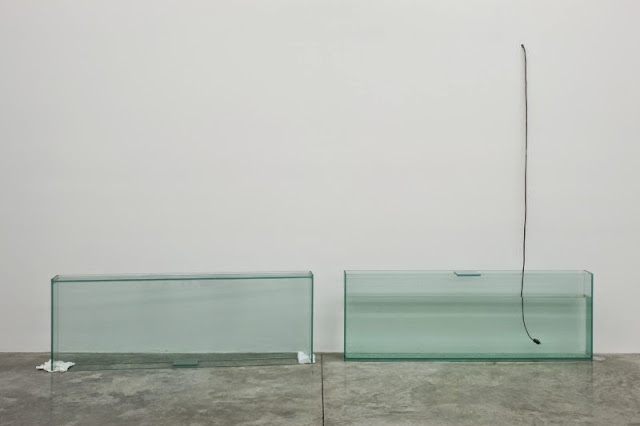Jason Dodge at Casey Kaplan Gallery
In many ways a gallery is a stage, lacking only a proscenium and seats. In the case of conceptual artist Jason Dodge, there are acts and there are props, and art emerges between them. For his recent exhibition ‘We Are the Meeting’, Dodge presented us with off-stage events, evidence of suspicious acts, and charismatic objects that connected the aesthetic moment of a gallery visit with an event of significant symbolic order. What appears at first to be a random selection of mundane objects with
no correlation to one another, or to any system of implied meaning,
begins to reveal layers of narrative verging on the dramaturgical. Dodge
is not altogether concerned with providing an experience of clear-cut
artistic value; his works do not 'look like' art but more like specimens
of evidence at a crime scene or an archeological dig; they are models
for the advancement of a form of social anthropology.
The first room holds a lightning rod, pointing north, with a set of silverware taped to its upper extremity, a gold-colored bed pillow, and a whole metal chimney. The pillow lays on the floor near the other objects and is titled The Mayor Is Sleeping (2013). Its title refers to its use before being exhibited here, as a pillow upon which, for a period of time measured in weeks or months, the mayor of Nurnberg, Germany slept, transferring some charismatic quality with it to the blank and unremarked space of the gallery. Dodge likes objects that have been used by persons outside the exhibition, or objects that are even being used elsewhere and exchanged for new ones to be exhibited. He wants us to feel that we are not exiting life to view art, but that art is a means by which we enter a stage where a greater perspective on life is possible.
The second room is mostly empty except for Carrier (2013) which consists of a large round straw basket with a high voltage flood light clamped onto it, facing a similar lamp attached to a nearby wall and placed so close that the lamps nearly kiss. Along one wall there is a bunch of empty tissue paper boxes each holding a deodorant dispenser, cumulatively titled What we keep doing to ourselves (2013). One can only imagine that Dodge is hinting at the act of using a corporately formulated chemical agent to ‘dry’ ourselves irrespective of possible side effects, when a tissue would do just as well. Despite the slight nod towards a social issue, this piece was meant mainly as a preparation for the transformative experiences on the other side of the door beside which they were placed.
Traveling along the wall from the front office was a length of electrical wire, and through its back wall into the next room, is a thin copper pipe. The wire enters through the south wall and travels around the room counterclockwise until on the north wall it exits through a hole. Another wire enters the room along the western wall until it reaches up to where the other wire exits, where the wire itself ends in a copper fork. The small copper pipe is filled in with hemlock, the poison used to execute Socrates. The uncapped copper pipe, like the electrical wires, is not connected to anything but traverses every room in the gallery, bringing both its physical presence and the implied danger of its exposed poison, into the open air.
Along one side of the third room is a long wall, mostly unlit, where the electrical wire enters and dangles down into a large tank of clear water beside another similar tank with ragged paper towels peeking out from under edges at each end. The work, titled Electric (2013), takes on an added dramatic quality, an air of danger where supposed electricity meets up with a heavy mass of water--a metaphor with elemental qualities that could almost be read as relating to the flood which affected many Chelsea galleries, including Casey Kaplan, during Hurricane Sandy.
The main event in this space seemed to be a work in progress; the random but timed replacement of a set of garishly white fluorescent tubes for rose coloured ones. Groups of each are left upon the floor and a large metal ladder stands ready for use. One never sees the tubes being changed but they obviously are, and the change creates an altered mood, in which we are forced us to see the room as a reflection of colour and not as a mass of details. What is important to Dodge in this instance is the quality of light, which is specifically aesthetic yet commonly taken for granted. We see the action and the objects but we are rarely conscious that light, like electricity or poison, can have presence without being understood.
Just before exiting the room, one may or may not notice a shopping bag filled with various organic groceries that has been left in a far corner of the room, and is a doppelganger to the one placed just inside the entrance to the gallery. These anonymous sculptures combine use value with the generic quality of a stage prop, and together they form a chorus of the commonplace.
‘We Are the Meeting’ presents us with objects and materials that each have a story to tell, and yet in order to make use of the metaphorical power they have as objects, and our physical encounter with them, it is important for Dodge to suggest a story without telling it. Each element here makes a contribution towards our education in understanding how meaning infuses art, and how that degree of meaning is already part of life, and not the sole purview of an art object. We are the audience and we are the committee. A meeting has concluded and the outcome though unsure, is important.





Comments